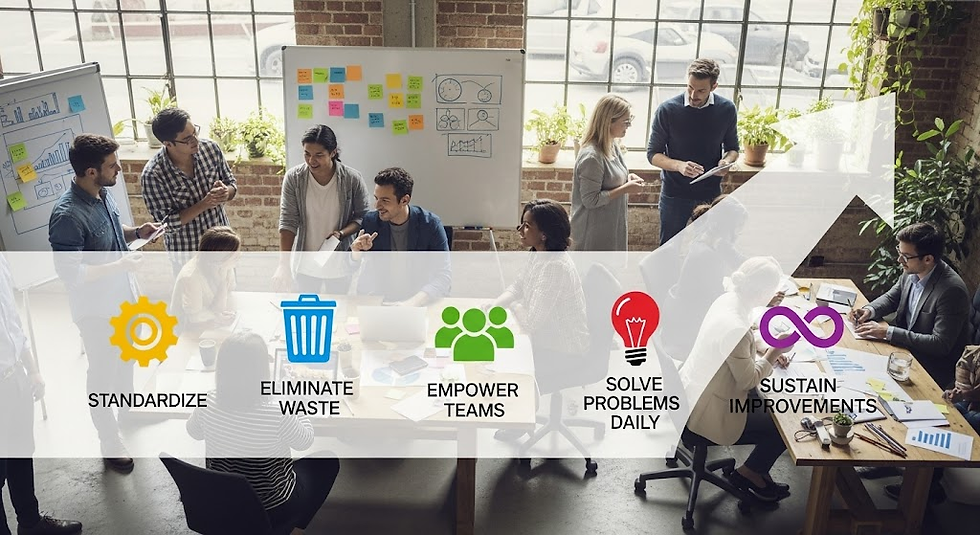Achieving Excellence in Food Delivery Services
- KPM SMARTBiz

- Sep 7, 2024
- 10 min read
Food Delivery Services: Navigating Operational Excellence through the Strategic Integration of Kaizen, Lean Six Sigma, and BIDA.
Running a food delivery service is not just about transporting meals from point A to point B. It requires seamless logistics, technology, customer service, and driver management coordination while maintaining strong relationships with partner restaurants. In the fast-paced world of food delivery, operational efficiency is critical, and success hinges on addressing key challenges. This article will explore how integrating Kaizen, Lean Six Sigma, and Business Intelligence and Data Analytics (BIDA) methodologies can revolutionize the food delivery landscape.
Logistics and Delivery Efficiency: Optimizing Delivery Routes and Minimizing Delivery Times
The heart of any food delivery service is its logistics. Optimizing delivery routes and minimizing delivery times directly impact customer satisfaction and operational costs.
Here’s how Kaizen, Lean Six Sigma, and BIDA can enhance logistics efficiency:
Kaizen: Implement continuous improvement workshops to review and refine delivery routes regularly. Encourage feedback from drivers and customers to identify potential improvements in delivery efficiency.
Lean Six Sigma: Analyze delivery data to identify bottlenecks and inefficiencies. Apply Lean Six Sigma principles to streamline delivery operations by optimizing route planning, reducing waiting times, and improving order batching.
BIDA: Leverage data analytics to track delivery performance, monitor real-time traffic conditions, and optimize route assignments based on historical data. By integrating GPS technology, you can reduce delivery times and improve customer satisfaction.
Example: XYZ Delivery Service used Lean Six Sigma to analyze delivery times and implemented an algorithm for optimized route planning. By doing so, they reduced average delivery time by 15%, leading to a significant increase in customer satisfaction and repeat orders.
Customer Service: Handling Order Accuracy, Complaints, and Timely Resolution
Customer service is the backbone of any successful food delivery business. Handling order accuracy and resolving complaints efficiently are essential to maintaining customer loyalty. Here’s how to elevate customer service using Kaizen, Lean Six Sigma, and BIDA:
Kaizen: Implement continuous improvement workshops to train customer service teams on effective complaint resolution. Foster a customer-centric culture that encourages staff to go above and beyond in addressing issues.
Lean Six Sigma: Use root cause analysis to identify the most common sources of customer complaints, such as order inaccuracies or delayed deliveries. Standardize processes to ensure consistency in customer interactions and order fulfillment.
BIDA: Utilize real-time data to monitor customer feedback and identify trends in complaints. By analyzing customer interactions and response times, you can implement proactive solutions to enhance service quality.
Example: XYZ Delivery Service implemented a BIDA-driven dashboard that tracked customer complaints and response times. This enabled the team to address issues faster and resolve 80% of complaints within 10 minutes, significantly improving overall customer satisfaction.
Driver Management: Recruiting and Managing a Fleet of Delivery Drivers
Efficient driver management is critical to ensuring timely deliveries and smooth operations. Here’s how to optimize driver recruitment and fleet management using Kaizen, Lean Six Sigma, and BIDA:
Kaizen: Foster a culture of continuous improvement by regularly engaging with drivers to gather feedback on their experiences. Use this feedback to refine recruitment processes and enhance driver retention.
Lean Six Sigma: Apply data-driven analysis to optimize driver schedules, performance metrics, and route assignments. Implement standardized protocols for driver onboarding, training, and performance evaluations.
BIDA: Utilize data analytics to track driver performance, fuel efficiency, and route adherence. Predictive analytics can help forecast staffing needs during peak times and optimize resource allocation.
Example: XYZ Delivery Service used BIDA to track driver performance metrics such as on-time deliveries, fuel consumption, and customer ratings. By doing so, they were able to implement a driver incentive program, which improved overall performance by 20%.
Partner Restaurants: Maintaining Relationships with Partner Restaurants and Managing Commission Rates
Building and maintaining strong relationships with partner restaurants is vital for a successful delivery service. Here’s how Kaizen, Lean Six Sigma, and BIDA can help manage these partnerships effectively:
Kaizen: Regularly collaborate with partner restaurants to streamline communication and order fulfillment processes. Implement feedback loops to address challenges and enhance partnership quality.
Lean Six Sigma: Analyze the performance of partner restaurants and identify opportunities for process improvements. Standardize order processing protocols to minimize errors and enhance the speed of fulfillment.
BIDA: Use data analytics to monitor order volumes, customer preferences, and restaurant performance. Adjust commission rates based on performance metrics and market trends to maintain profitability and partner satisfaction.
Example: XYZ Delivery Service implemented a Kaizen initiative to foster stronger communication with their restaurant partners. This resulted in a 15% improvement in order accuracy and strengthened relationships with key restaurant partners.
Technology Integration: Managing Online Ordering Platforms and Mobile Apps for Seamless Customer Experience
In today’s digital age, technology plays a crucial role in the success of food delivery services. Here’s how to optimize online platforms and mobile apps using Kaizen, Lean Six Sigma, and BIDA:
Kaizen: Continuously improve the user interface of online ordering platforms and mobile apps. Gather feedback from customers and drivers to enhance usability and functionality.
Lean Six Sigma: Use data analysis to identify common issues within the ordering process, such as app crashes or delayed notifications. Standardize updates and bug fixes to ensure a seamless customer experience.
BIDA: Monitor customer behavior data on online platforms to identify trends in usage and preferences. Use this data to optimize app features and improve the overall customer journey.
Example: XYZ Delivery Service leveraged BIDA to analyze app usage patterns and implemented updates that improved the user experience. These enhancements led to a 25% increase in app downloads and a 10% boost in order volume.
Case Study: Streamlining Operations and Enhancing Efficiency in XYZ Food Delivery Services






